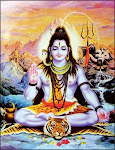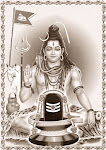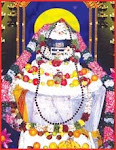
Friday, 12 March 2010
HINDUISM
Maha Sivarathri: day-long fast and night-long vigil
Chelvathamby Maniccavasagar
Maha Sivarathri is one of the most important festivals of Hindus dedicated to Lord Shiva.
On this day devotees will fast and keep vigil throughout the night repeating the words ‘Om Sivayanama’. Poojas are be conducted at Shivan Temples during the four quarters of the night accompanied with devotional songs, Mantra recitation, the lighting of the sacred fire and the rendering of classical dances dedicated to Lord Shiva.
God Shiva and Parvathi
God is omnipotent and all pervasive. By the nature of these qualities He is formless. But in order to enlighten his devotees He takes innumerable human forms. On Maha Sivarathri Day Lord Shiva manifests Himself in the form of a Lingam. The prime manifestation with the form of the formless Shiva is known as ‘Lingabhavanamoorthy’ and He is said to make His appearance in that form at midnight on Mahasivarathri Day.
On this auspicious occasion Lord Shiva performs the cosmic dance.
This divine dance is the thrilling expressions of God realisation by one who has transcended the limitation of the material layer of one’s personality. This divine dance portrays the world being formed and dissolved. The cosmic activity is the central motive of the dance. Shiva’s dance balancing on one foot signifies the single pointed attaintment of a man of realisation with the absolute God.
The Dwarfish demon which lies conquered and crushed under His foot represents the Ego. When the Ego and desires are kept under control the man of perfection experiences with himself the pure transcendental essence of divinity.
Ratri means night when it is dark. Darkness stands for lack of knowledge. Lord Shiva’s dance on Maha Sivarathri indicates that His transcendental experience of the reality is unknown to the rest of the mankind.
--------------------------------------------------------------------------------
Night of Shiva symbolises purification
Maha Shivaratri is a fast, and the religious ceremonies take place chiefly at midnight of the day. Pious Hindus abstain from food and drink during the day and at night worship God Shiva. The prefix ‘Maha’ means great and ‘Shiv’ denotes benefactor and ‘Ratri’ signifies ignorance and darkness. The word ‘Shiva’ also means one or who liberates mankind from sorrows and sufferings and leads them on the path of virtue and peace.
The progenitors of humanity are called by various names by different religions, i.e. all the eternal human souls have just one single Eternal Father, called God with varying names in different languages and religions. God has been ordained and idolized through various oval shapes and symbols. God Shiva has been venerated as the divine incorporeal form of light, the Jyothir Bindu.
Significance
Let us understand Shivratri in its true significance. The Night of Shiva signifies not the usual darkness resulting from the revolution of earth around the sun, but this alludes spiritually to the darkness of ignorance. Power of five vices - lust, greed, anger, attachment and ego has overshadowed our intellect, deprived us of our true nature - peace, purity, contentment, love, bliss, humility etc. These have been the main reason for the moral degradation we are witnessing in today’s iron-aged world.
The world today has overlooked the difference between the ‘original’, pure, positive self and the ‘acquired’ demonic negative self.
Bowl of gold
People do not know that the secret of achieving total success in life without having to struggle lies in rediscovering, realizing, restoring the lost truth - the biggest truth - that we are originally and essentially spiritual beings, souls, the spiritual battery that runs the human body.
There was a beggar who usually went to jewellers market for begging. He used to get some coins or food and days passed on. Once the son of a famous jeweller summoned the beggar and asked him to show his bowl and after inspection he told him that the bowl was made of gold. But the beggar did not believe him. So he took him to a well and asked to clean the bowl.
Purification
After cleaning it started shining and glowing. Similarly, I, the soul, am a subtle star, a point source of light energy and consciousness.
Nothing happens by chance in the spiritual world. Shiv Jayanthi, Divine Descent or birth of God Shiva, the Supreme Soul, the Supreme Father takes place at a time when He is needed most, i.e. when the world touches the lowest depths of degradation, sin, misery etc. This indicates the truth that He comes when total darkness of ignorance prevails in the universe. It is observed year to commemorate the event of the descent of Almighty God.
On Maha Sivratri day, at the end of each quarter of night, to symbolize purification of the soul, a bath, Abhisheka is performed to the Shivalingam with milk, curd, ghee, honey, turmeric, rose water etc. Fast and vigilance on this night coupled with the baths are said to give happiness in this and the next world.
God Shiva does not take birth as we, human beings, or as the other beings do. He, the most exalted and the most extraordinary one, takes an extraordinary birth.
Sleeping soul
He descends on the intellect of a human being and use his organ of speech to articulated the Godly knowledge and to teach mankind the methods whereby they can attain peace and perfection. The human persons on whom He descends and through whose mouth, He reveals the Godly knowledge, comes to be known as Prajapita Brahma or Adi Dev. By means of this knowledge, He established a new socio spiritual order, which is known as the Golden Age or Satyuga.
Swami Vivekananda said: Teach yourselves and teach everyone about the real nature, call upon the sleeping souls see how it awakes. Power will come, goodness will come, purity will come and everything that is excellent will come when this sleeping soul is roused to self-conscious activity. So let us endeavour to free the world of vices, to do away with body consciousness through sacred truths. Let us help God to create a world of reason, a world where science and spirituality will lead to peace and happiness.
The true art of living lies in realizing the differences, reviving the original dignity of our soul, and then allowing that experience be the driving force behind our very action and make this iron-aged world into a golden-aged one.
Brahma Kumaris Raja Yoga Centre - press release
--------------------------------------------------------------------------------
When is Shivarathri?
Shivaratri 2010 is on February 12, Friday.
When is Shivaratri auspicious festival of Mahashivaratri. Is it on the 13th or the 14th night of the new moon during Krishna Paksha in the Hindu month of Phalgun.
The Sanskrit term, Krishna Paksha means the period of waning moon or the dark fortnight and Phalguna corresponds to the month of February - March in English calendar. Shivaratri Festival is celebrated on a moonless night.
According to Hindu mythology, Shivaratri or ‘Shiva’s Great Night’ symbolizes the wedding day of Lord Shiva and Parvati. Many, however, believe, Shivaratri is the night when Lord Shiva performed the Tandava Nritya - the dance of primordial creation, preservation and destruction. Celebrating the festival in a customary manner, devotees give a ritual bath to the Lingam with the panchagavya - milk, sour milk, urine, butter and dung. Celebrations of Shivaratri Festival mainly take place at night. Devotees of Lord Shiva throng Shiva temples across the country and spend ‘the Night of Lord Shiva’ by chanting verses and hymns in praise of the Lord.
The festival holds special meaning for the ladies. They pray to Goddess Parvati also called ‘Gaura’, the giver of ‘suhag’ (blessings) for good husbands, marital bliss and a long and prosperous married life.
Courtesy: web.mahashuvarathri.org
--------------------------------------------------------------------------------
He who sees God - sees the epic of faith
Sivanandini Duraiswamy
“First the battle of life. Let the virtue in you vanquish the vice. Lead a dharmic life true to your nature or Svadharma based on self-control and complete surrender to the Lord. The Divinity within is your ever-available guide. Attuning yourself to it, do your job as splendidly as you can. Every one is obliged to wage the Mahabharata war in and through his life,” is the succinct theme of the Bhagavad Gita, which prompted Gurudev Swami Chinmayananda to choose the Gita as an important text for his Jnana Yagnas Materialistic tendencies over-power humanity and the refreshing teaching of the scriptures help to regain the glory of being human. “Let us spread peace, joy and love through the study of our great scriptures and selfless services towards humanity,” was his aim.
Man of prowess
“Yield not to unmanliness, O son of Partha - it does not become you a man of prowess. Cast off this faint heatedness and wake up,” was the message to Arjuna when he was in a dilemma whether to fight the Kurukshetra war or flee the battlefield. This is the great battle for an inner victory and the yearning cry of the embodied Soul ready to give up the battle of life. It is afraid of the annihilation of its desires and its attachment to near and dear ones.
In times of crisis when man is tortured by doubt and conflict between his duties and the attachment to worldly, he becomes helpless. It is then that he turns to God for light and guidance as Arjuna did when he was torn between performing his duty of upholding the righteousness and his misplaced compassion towards his relatives. This is not merely an incident where a lesson is taught; it is an allegory referring to the eternal struggle that man faces between the righteous aspirations and his unrighteous desires.
Veritable battlefield
The great battle for the Kingdom between the Pandavas and Kauravas was declared. Lord Sri Krishna was Arjuna’s Charioteer who in the beginning drove up to the battle lines so that they may survey the battle array. On seeing his own kinsmen poised for battle on the enemy ranks Arjuna was deeply disturbed - was he to fight and punish his relatives for their unrighteousness or was he to flee the battlefield, was his dilemma. It was at this crucial moment that Lord Sri Krishna inspired Arjuna with the teaching which is immortalized as the Bhagavad Gita.
Life is full of problems and is a veritable battlefield where man often faces Arjuna’s dilemma. He is unable to discern his course of action and is unequal to the challenges of the situation. He realizes his inadequacy and prays for knowledge and strength. Now comes the Eternal Voice of the Lord, which speaks of the imperishable nature of the Soul and the perishable nature of the body.
In this body, we pass from childhood to youth, old age and death; finally, death that begins another cycle crates a new residence for the Soul.
This is the inevitable cycle of birth and rebirth. But in this changing cycle, the Soul is unchanging and Real. “It is unborn, eternal, changeless, and ancient,” says the Lord and adds that just as one discards old clothes and changes into new ones, the embodied Soul sheds its useless body only to take a new one. “When this is the truth, Arjuna, who kills whom?” asks the Lord.
Right to work
Having convinced Arjuna of the immortality of the Soul, the Lord calls him to action. “Perform your duty renouncing the fruits of action with your heart fixed on the Supreme Lord. You have the right to work but for work-sake only. You have no right to the fruits of work.”
To be continued
--------------------------------------------------------------------------------
Folk deities:
Sacrificing the life of Thelli Veeran
Thilaba T. Wijeyaratnam
Long long time ago there was a small regency in South India. During the time when irrigation was needed for the paddy fields, the sluice gates of a tank were opened. But the water wouldn’t come out.
The people were mystified. No body had the courage to get down to see what was wrong. The ruler a little maharaja was informed of this. He rode on a horse back to the spot. He announced “If any man could remove whatever obstructs to open the gates and let the water flow, he will be given one-fourth of the fish in the tank.”
There was a young fisherman called Thelli Veeran among the crowd. He came forward and said that he would do it. But said he might not come out alive.
If he lose his life he requested his family members for generations be given the fish. The little ruler agreed to honour the deal.
The young fisherman jumped in. He found out what was obstructing the flow of water. He came up and told that there was a massive python got stuck in the space where water flows. It would not more either forward or backward. He promised to have it removed by evening and if he died in the process his dead body to be buried near the tank under the tamarind tree there.
He came as he said in the evening. He brought a net and on its ropes were sharp nails. He told his cousin to wrap the iron net round his body. The net was like an armour. He worshipped everybody present for the last time and jumped in. After about an hour water started trickling out - first red with blood and then the people saw the head of the python.
Then slowly the python came out with blood oozing out of its body.
It was clear the young man had grappled with the creature. Once the python came out the water gushed out.
When the python finally came out the young man holding its tail also was seen. The python had crushed his body and was pierced by the nails. The young man was killed during his fight with the python.
The young man gave up his life for the people. So a temple was built where he was buried.
The fish went to his people as promised and to his generation to this day. This is how folk deities came to be in many villages in India. No Brahmin officiates at these temples. The village people gather annually and offer all the food the deity desired. It is in such places fowls or goats are sacrificed. This is the village tradition and certainly not Hindu tradition. Hinduism advocates Ahimsa non-violence. Because of their rites performed in three ‘temples’ of the folk deities.
There is a misunderstanding that Hinduism allows animal sacrifice. Hinduism strongly believes in Thiruvalluvar’s word’s in the couplet No 260.
“All living beings would warship him who neither kills no eats flesh.”
The tales of these folk deities have been written to enlighten non-Hindus that Hindus do not sacrifice other lives to better their lives. Simple ignorant village folk who are not enlightened on the principles of Hindu philosophy resort to such actions until as in Sri Lanka, animal sacrifice is brought to an end.
Sources: Kalaniooran/courtesy: Kalk.
--------------------------------------------------------------------------------
History of Hinduism
The earliest evidence for prehistoric religion in India date back to the late Neolithic in the early Harappan period (5500 - 2600 BCE). The beliefs and practices of the pre-classical era (1500-500 BCE) are called the “historical Vedic religion”.
Modern Hinduism grew out of the Vedas, the oldest of which is the Rigveda, dated to 1700-1100 BCE. The Vedas center on worship of deities such as Indra, Varuna and Agni, and on the Somaritual. They performed fire-sacrifices, called yajna, and chanted Vedic mantras but did not build temples or icons. The oldest Vedic traditions exhibit strong similarities to Zoroastrianism and other Indo-European religions.
The major Sanskrit epics, Ramayana and Mahabharata, were compiled over a protracted period during the late centuries BCE and the early centuries. They contain mythological stories about the rulers and wars of ancient India, and are interspersed with religious and philosophical treatises. The later Puranas recount tales about devas their interactions with humans and their battels against demons.
Three major movements underpinned the naissance of a new epoch of Hindu thought: the advent and spread of Upanishadic, Jaina, and Buddhist philosophic-religious thought throughout the broader Indian landmass. Mahavira (24th Tirthankar of Jains) and Buddha taught that to achieve Moksha or Nirvana, one did not have to accept the authority of the Vedas or the caste system.
Buddha went a step further and claimed that the existence of a self/soul or God was unnecessary. Buddhism peaked during the reign of Asoka the Great of the Mauryan Empire, who unified the Indian subcontinent in the 3rd century BCE.
After 200 CE several schools of thought were formally codified in Indian philosophy, including Samkhya, Yoga, Nyaya, Vaisheshika, Purva-Mimamsa and Vedanta. Charvaka, the founder of an atheistic materialist school, come to the fore in North India in the Sixth century BCE. Between 400 BCE and 1000 CE Hinduism expanded at the expense of Buddhism.
Sanskritic culture went into decline after the end of the Gupta period. The early medieval Puranas helped establish a religious mainstream among the pre-literate tribal societies undergoing acculturation. The tenets of Brahmanic Hinduism and of the Dharmashastras underwent a radical transformation at the hands of the Purana composers.
Source: wikipedia
DAILYNEWS.LK







No comments:
Post a Comment